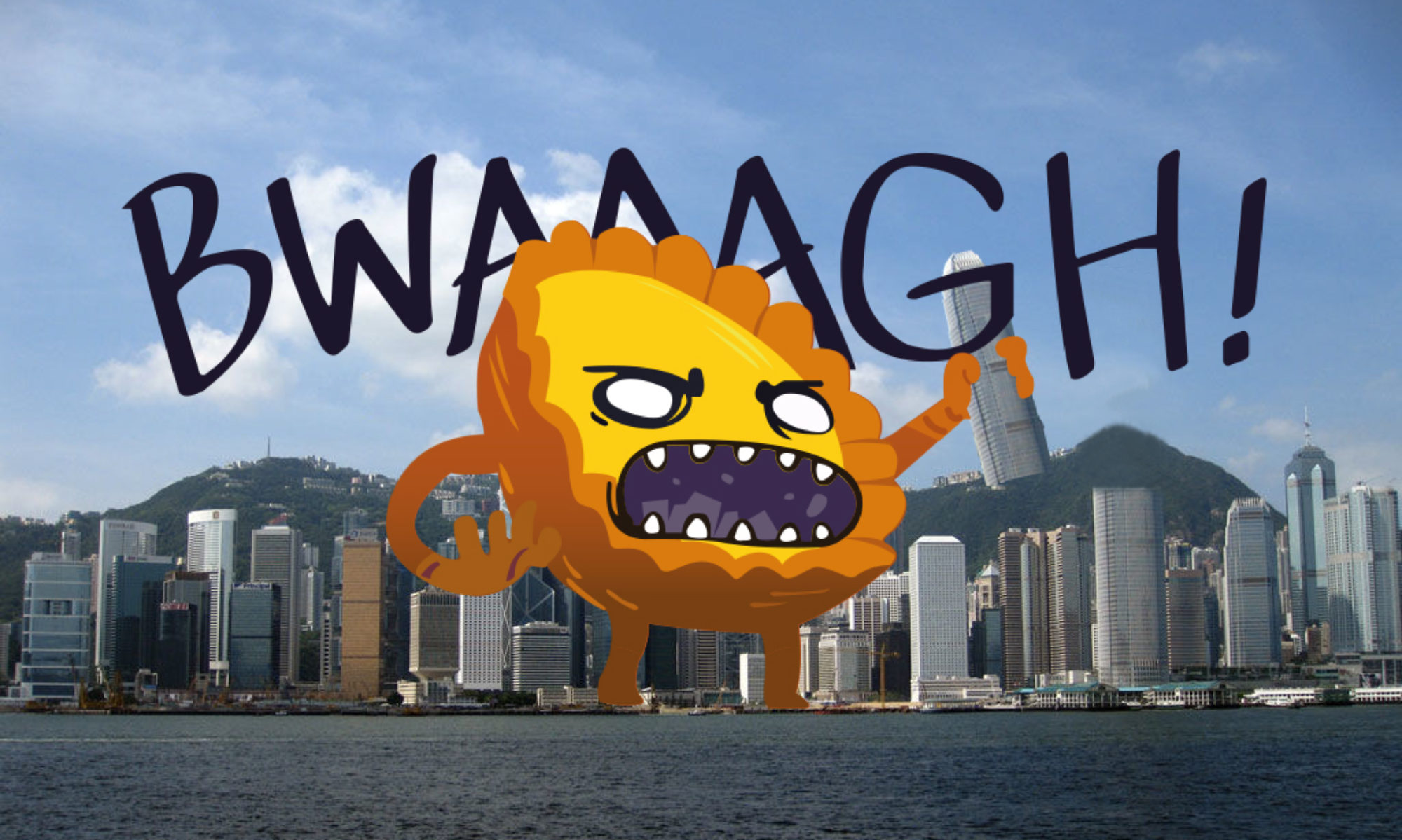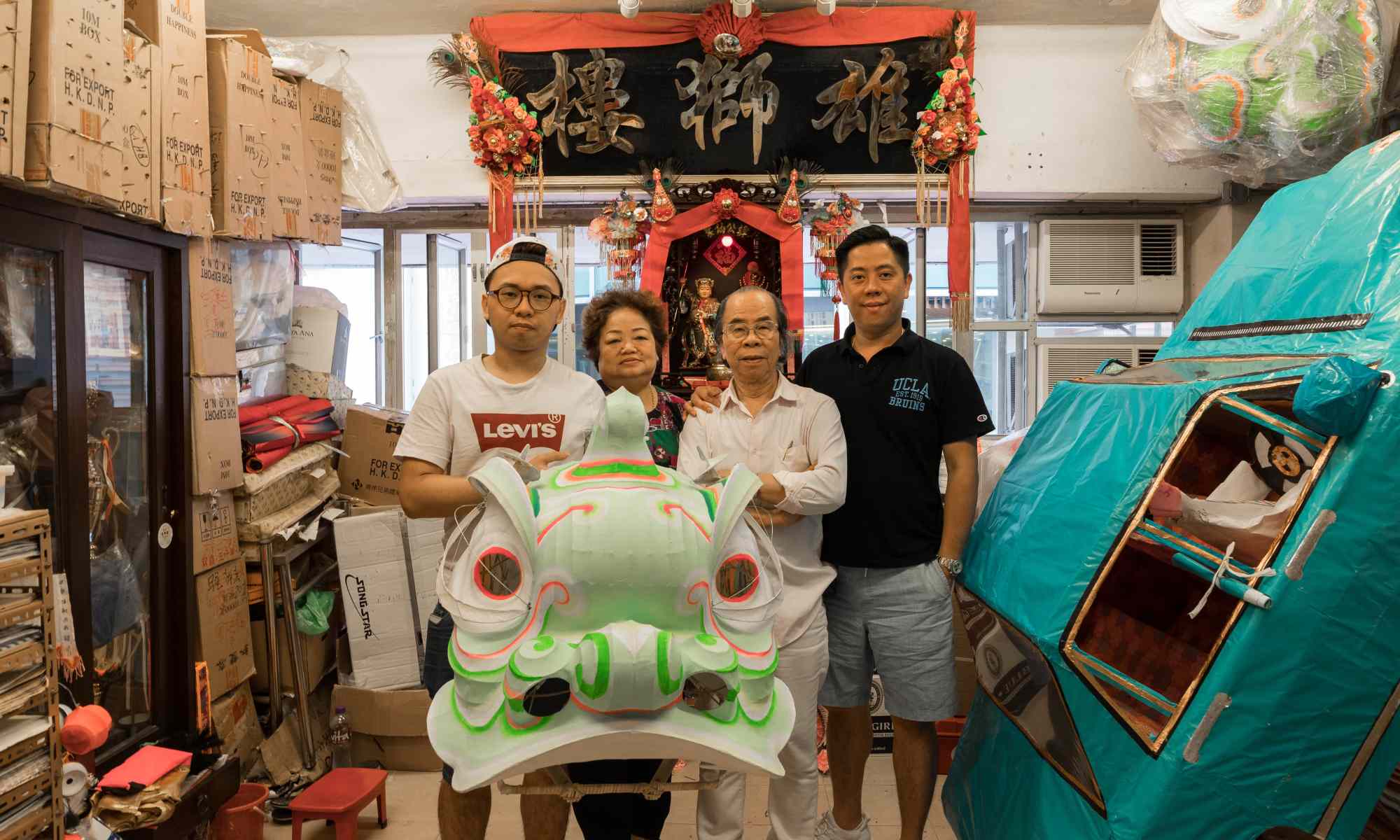Written by Billy Potts
This is the sixth in a series of articles in which I explore the cryptozoology of Hong Kong. This article was published in a shorter form in Zolima City Mag.
Under a busy flyover, where the Island Eastern Corridor becomes Chai Wan Road, sits an unassuming shopping arcade. A mezzanine corridor strewn with paper lanterns, plastic flowers and a wild array of funereal offerings leads to the venerable paper crafts workshop, Hung C Lau (雄獅樓). A large paper car leans haphazardly against a wall while paper servants stand guard at the door. Amidst this melange we find Anita Jack and Dan Beck of the Golden Dragon Museum.

Since the museum’s last visit to Hong Kong, Sun Loong made his final solo appearance at Bendigo’s 2018 Easter Parade. This marks the end of an era and paves the way for Dai Gum Loong’s arrival. Anticipation for the the new dragon has already begun to build. Bendigonians are anxious to see the form in which Dai Gum Loong will manifest at next year’s parade, where the 21st century dragon will be awakened, blessed, fed with pomelo leaves and then lead to his new museum home by Sun Loong in a dual procession.
In this time, Jack and her team have narrowed down their short list of three dragon makers: Master Kenneth Mo, Master Hui Ka Hung and Master Ringo Leung. In the end it was a head to head race between Hui and Leung – each was loaned one of the museum’s precious dragon scales, and given the task of creating a silk and paper variant based on it. Each master’s scale was judged on artistic merit and workmanship. ‘Both were good quality and very similar to what we currently have on our dragons’, beams Jack. Both masters were flown to Bendigo and given the chance to unlock the secrets of its two imperial dragons.


Meet the Hui Family
In Shau Kei Wan, the groaning of trams trundling by can be heard just outside as three generations of Huis huddle around a folding table with Jack, Beck and their translator, Heidi Yeung, ironing out a draft contract which will seal their agreement. Dan Beck surveys the 300 sq ft workshop. Beck, a lion dancer since the age of seven, has extensive knowledge of Chinese paper crafts and performing arts. ‘You can see that he’s planed the inside edges of the cane’, Beck notes, running a finger along the skeletal frame of a lion’s head. ‘It makes the structure stronger’ he elaborates, as though this were obvious. These details distinguish master craftsmen from rank amateurs and it is to the former group which the Huis belong.
Hui Ka Hung (許嘉雄) grew up in a world of kung fu and the associated arts of lion and dragon dancing. The young Hui began taking an interest in the lions’ heads, dismantling, re-assembling and repairing them. The autodidactic child grew into a craftsman and at just 7 years old he produced his first leonine work of art. At 13 he was taken on as an apprentice at a paper crafts shop and has never done anything else.
Hui’s father, Hui Cheung Zun (許祥進), sits close by. Photographs of the patriarch as a young man are scattered around the workshop. In them he ripples with lean muscle, performing leaping feats of kung fu. The retired businessman became a paper crafts sifu by learning from his son, rather than the other way round. ‘People think it’s funny’, Hui laughs, ‘because most of the time they assume that the craft is passed down through the generations but I’ve passed it down to my father!’

Rounding out the team is 19 year old Hui Siu Kei (許兆基), Hui’s nephew, who grew up in the shop. Helping out before and after school, the youngest Hui left his studies at 16 and has since devoted all his time to making lions and dragons – he is a master craftsman in his own right. ‘Compared with me he’s a late starter’, Hui says of his millennial protege. But even so, the Junior Hui makes up to 120 lion heads a year compared to the several dozen a year that his Uncle made at the same age. Dai Gum Loong will be the young sifu’s 5th dragon and he will be given the task of painting the head, alongside his illustrious uncle.
‘We are very happy doing this with 3 generations working side by side’ Hui Sr. beams. ‘This commission is very important to us because in this life there won’t be a second chance to do anything like this’, adds Hui. The elder Hui feels it is fate that has brought Dai Gum Loong to their doorstep. ‘Lo On sifu was 39 when he made Sun Loong and [my son] is 39 as he is about to create Dai Gum Loong. He even bears a slight resemblance to Lo On!’ Fate aside, both dragon makers are adamant about one thing: ‘I just want to say that we’re doing this dragon for the honour and prestige, not the money.’ Hui Sr. raps a bejewelled finger on the table to punctuate this point. To put this into perspective, Anita Jack draws this analogy: ‘As an artist [this] is like being asked to paint the Sistine Chapel, you only get one shot.’

The three sifu will work primarily on Dai Gum Loong’s head but there is much else to be done. Dai Gum Loong will likely surpass 120m in length and will be covered from, head to tail, in ornate handmade scales – 7000 scales or thereabouts. Hui’s entire family will be involved in this huge task. It took Hui a full day to make a single sample scale. At a conservative estimate, the entire family will be able to produce 10 to 20 scales per day. Hui believes they will become faster with practice. ‘Don’t ever say that the 6 figure price on this dragon is extravagant – considering all the work that will go in, this will be hard earned money’.
The dragon masters of Hung C Lau will have to bring all their skills and imagination to bear in this challenging endeavour. ‘It’s going to be very difficult’, says Hui Sr. Do the the dragon makers have any doubts? Hui grows serious: ‘Look, when I say I can do this it’s not just talk. I don’t have a single doubt in my heart. I have faith and confidence in our abilities.’
Hui’s mission to save the dragons of Hong Kong
These days Hong Kong dragons and their makers are both endangered species. On visiting The Golden Dragon Museum, Hui was saddened to see that a foreign land had better preserved his cultural heritage than Hong Kong has. ‘In the museum, surrounded by all those Chinese artefacts, it felt sublime. Hong Kong is so famous for its paper crafts but the government hasn’t done anything to preserve them. On the other hand, private citizens in Australia, of all places, have amassed this huge and precious collection.’

The dragon maker feels it is high time for the commercially minded, unsentimental government and people of Hong Kong to wake up. ‘[Hong Kong] is lagging behind by 50 years. If we don’t do something our precious artefacts will only exist elsewhere and we will have nothing! What a shame that would be.’
The paper craftsmen of Hong Kong face many dangers. Not least of these is their dwindling number. By Hui’s count there are now fewer than 30 sifu capable of creating lions and dragons. Even fewer do it full time. As of 2016, the Golden Dragon Museum was only able to identify 5 Hong Kong craftsmen who would be capable of taking on a challenge like Dai Gum Loong. One of these, Au Yeung Ping Chi of Bo Wah (寶華) – a renowned paper crafts workshop, no longer practices his craft commercially. ‘There was a larger “hinterland” of craftspeople from whom the dragon makers could source materials and expertise for various decorative elements of a dragon than what is available now’, the museum concludes.
For his part, Hui does what he can to show Hong Kong and the world the beauty of his art. Aside from collaboration with the Intangible Cultural Heritage Office (ICHO), Hui is the only sifu in Hong Kong who is completely open about his working methods. ‘Lots of people don’t dare show their process [but] we don’t mind sharing it – we hope to be very transparent so you can see how this is done.’ Hui regularly speaks and carries out demonstrations at universities and schools in order to bring the culture of paper crafts to the attention of a wider audience. On one project with the Hong Kong Government he even agreed to the installation of cameras in his workshop to prove that his work was 100% made in Hong Kong. ‘I lasted longer than the camera’s batteries’, Hui laughs. ‘The cameraman had to come down at 2:00AM to change them’.
Hui speculates that a main reason for the secretive sifu may lie in the fact that they could be outsourcing to China. For years now, Hong Kong’s paper artisans have faced stiff mainland competition, which takes a different approach to this traditional craft. ‘In Hong Kong it is an art but in the Mainland it’s an industry’, Hui sighs. ‘They don’t talk about quality, only money. In Hong Kong we do this for the joy of creating something beautiful, not to earn a few thousand more.’ Since the 80s, according to Hui, Chinese factories have turned this delicate art into an industrial process. Where once a knowledgeable sifu would have created lions and dragons from frame to finish, Chinese factories have split the work into production lines with unskilled labourers working on parts in isolation. The results are rough chimerical approximations with low price tags to match.
The opening up of China’s markets and the resulting price war has caused the Hong Kong paper crafts industry to collapse. ‘We used to be able to sell one lion head for $15,000. which is amazing for the time because gold was worth $2000 per ounce. That means a lion was worth about 7 or 8 ounces of gold. Formidable! Once the mainland opened up, the price dropped to $200’ Hui laments.

The greatest dragon maker in the world
The contract between Hui and the Golden Dragon Museum was finally signed on the 30th of May 2018. Amidst the roar of drums and acrobatic displays of lion dancing, the Premier of Victoria, Daniel Andrews, presided over a raucous signing ceremony. The Premier and Jack reasserted their firm belief that they had found their man in Hui.
Now all eyes are on Hong Kong and its paper craftsmen. Alongside Hui, other sifu (Master Ringo Leung and Master Yu Hou), will also have their share of the limelight as they create magnificent qilins and lions to join Dai Gum Loong’s cortege. Master Leung may also have a hand in restoring Sun Loong.
The race is on for Hong Kong to create the greatest imperial dragon the world has ever seen. Unlike his predecessors, who only enjoyed the hermetic environs of the Golden Dragon Museum for the latter parts of their lives, Dai Gum Loong will spend his entire life in the museum making it likely that he may live to parade for the next 100 years and beyond. Hui’s work and therefore the quality of Hong Kong’s craft will be under scrutiny for well over a century.
‘You know’, Jack says to Hui, ‘if you make this [dragon] and it is what we expect, you’ll be the greatest dragon maker in the world. It’s that simple.’ Hui is unruffled. This is to be a herculean task for the dragon maker from Shau Kei Wan but, for the honour of his family and his home city, Hui is ready to answer the challenge.

